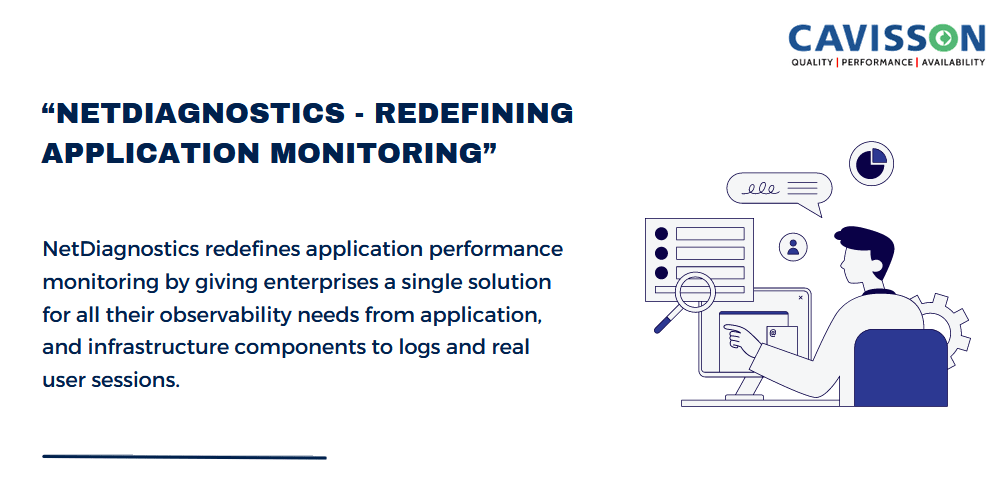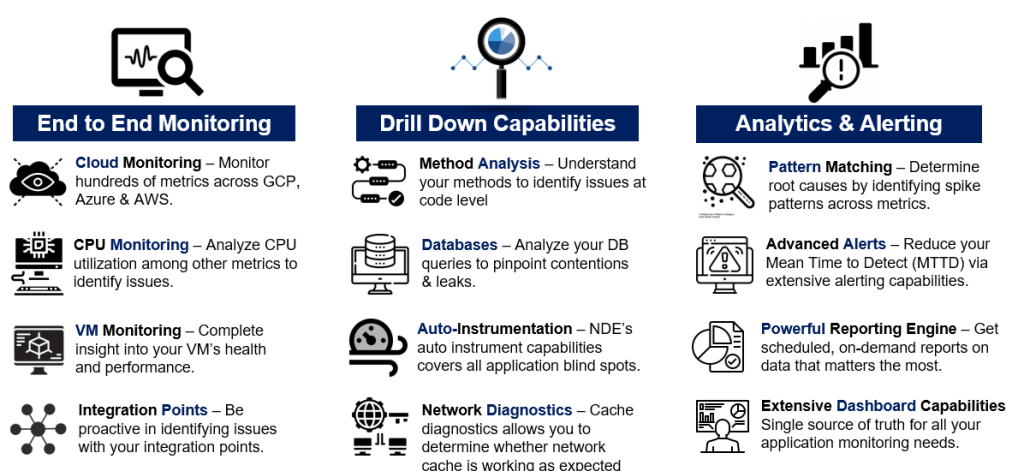
Introduction of NetDiagnostics:
NetDiagnostics is a next generation application performance monitoring (APM) tool developed by Cavisson Systems. Built to assist organizations in identifying the “why” behind application or system level issues, NetDiagnostics provides end-to-end observability by combining application, infrastructure, log and user monitoring in a single platform.
This approach not only eliminates the need to have multiple solutions for monitoring different components of your application landscape but provides context based information by combining varied data sources to assist your teams in drastically reducing the mean time to detect (MTTD).
Combined with NetDiagnostics’ advanced automatic root cause analysis or AutoRCA capabilities, teams are equipped to drill down to accurate root cause thereby also reducing the mean time to resolution (MTTR).
With NetDiagnostics, organizations can ensure peak application and system performance for their critical applications, reduce downtime, and improve overall user satisfaction, leading to increased efficiency and competitiveness in the digital landscape.
What should we look for in an APM?
When picking an APM tool, make sure to consider how affordable, scalable, easy to use, and reliable it is. These factors are crucial for making the right choice. Look for these specific features when choosing an APM tool:
- Setup simplicity: APM tools should be simple to set up and customize, requiring little to no technical knowledge.
- Real-time monitoring: APM tools should provide real-time insights into your applications and infrastructure performance.
- Flexibility: APM tools should be able to monitor a wide range of applications and platforms, with the ability to customize metrics and dashboards as needed.
- Alerting and notifications: APM tools should offer built-in alerting and notifications, allowing you to stay informed of performance issues as they arise.
- Performance analysis: APM tools should offer a detailed analysis of performance issues, including the ability to drill down to the code level to identify the root cause.
Cavisson NetDiagnostics APM offers all these features, making it a top choice for teams and organizations.
Key Capabilities in NetDiagnostics
Being in this application performance engineering space for more than a decade, Cavisson Systems intrinsically understands the core functionalities that organizations’ and teams require to effectively utilize a monitoring solution. With this in mind, NetDiagnostics provides an exhaustive list of features that are built to assist our users with actionable and context rich information to accurately detect and understand the root cause behind issues across your application stack. Let’s have a quick look at some of our key capabilities:

“Switching to Smart Monitoring: From Fixing to Preventing Issues”
Switching from fixing issues as they come up to actively keeping an eye out for potential problems is a big change in managing the performance and reliability of IT infrastructure. In a reactive model, organizations address issues as they arise, often after users have already been affected, which can lead to downtime, decreased user satisfaction, and potential financial losses. Proactive monitoring, on the other hand, is a forward-looking strategy that aims to anticipate and prevent problems before they impact operations. Start by setting clear goals, like minimizing downtime, improving user experience, or making better use of resources. It involves selecting appropriate monitoring tools capable of real-time insights and predictive analytics. Critical performance metrics are identified, and baselines are established to understand what constitutes normal operation.
With NetDiagnostics, you can create varied alerting rules like forecast, anomaly, outliers among others to notify the necessary teams when things go off track. Combined with auto-remediation capabilities, you can perform corrective steps for known issues without the need for any manual intervention.
By embracing root cause analysis, organizations can pinpoint the underlying causes of problems and address them proactively, rather than reactively. Overall, the shift from reactive to proactive monitoring is essential for enhancing operational efficiency and ensuring the continuous and reliable performance of critical systems and NetDiagnostics provides you with an extensive array of features to help you shift from reactive to proactive monitoring. This approach becomes essential for enhancing operational efficiency and ensuring the continuous and reliable performance of critical systems.
Are APM solutions worth the investment?
Consider development time. Many developers are often paid upwards of $50-$100/hour. If your team spends a week troubleshooting an issue that could’ve been identified in minutes with APM, the cost is almost invariably much higher than the $200-300 subscription fee.
For a more specific example, let’s say the a user authentication problem took your team two days to identify and fix. At a rate of $100/hour, that’s $4,000 in development costs — much higher than the cost of an APM solution.
Additionally, companies often suffer significant opportunity costs as a result of downtime, including lost customers, missed revenue opportunities, and brand damage. An APM solution can help you avoid such costs by ensuring your applications are running smoothly and delivering a superior user experience.
Generally, you think of APM solutions as a special form of insurance (with a twist). Most of the time, your application is functional and operating normally. But in the event of a major problem, an APM solution can help you diagnose and fix it quickly — saving your team time (and money) in the process in exchange for a small monthly fee.
Conclusion
In summary, NetDiagnostics is a modern way to manage applications performance monitoring. It provides a complete set of tools that go beyond the traditional monitoring. By providing real-time insights into application behavior, resource utilization, and user experiences, NetDiagnostics empowers organizations to streamline their operations and deliver optimal performance to end-users.
Businesses deal with the challenges of today’s complex applications and changing infrastructures, NetDiagnostics stands out as a clear choice in making sure applications perform at their best. Its ability to uncover hidden issues, reduce downtime, and enhance overall efficiency positions it as a go-to solution for IT teams striving to deliver exceptional digital experiences. In an era where user satisfaction is paramount, NetDiagnostics stands as a reliable ally in the pursuit of seamless, high-performing applications.
Contact us today to kickstart your Application Performance Monitoring journey.

